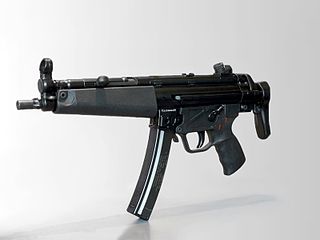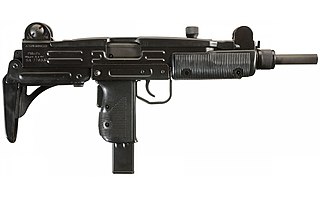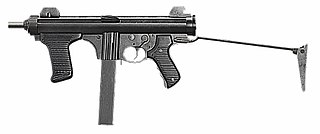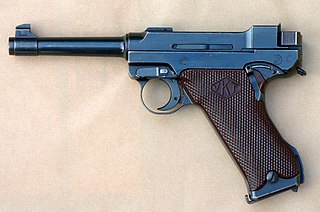
The Heckler & Koch MP5 is a submachine gun developed in the 1960s by German firearms manufacturer Heckler & Koch. It uses a similar modular design to the Heckler & Koch G3, and has over 100 variants and clones, including selective fire, semi-automatic, suppressed, compact, and even marksman variants. The MP5 is one of the most widely used submachine guns in the world, having been adopted by over forty nations and numerous militaries, police forces, intelligence agencies, security organizations, paramilitaries, and non-state actors.

A machine pistol is a handgun that is capable of fully automatic fire, including stockless handgun-style submachine guns.

A submachine gun (SMG) is a magazine-fed automatic carbine designed to fire handgun cartridges. The term "submachine gun" was coined by John T. Thompson, the inventor of the Thompson submachine gun, to describe its design concept as an automatic firearm with notably less firepower than a machine gun. As a machine gun must fire rifle cartridges to be classified as such, submachine guns are not considered machine guns.

The Uzi is a family of Israeli open-bolt, blowback-operated submachine guns and machine pistols first designed by Major Uziel "Uzi" Gal in the late 1940s, shortly after the establishment of the State of Israel. It is one of the first weapons to incorporate a telescoping bolt design, which allows the magazine to be housed in the pistol grip for a shorter weapon.

The Thompson submachine gun is a blowback-operated, selective-fire submachine gun, invented and developed by Brigadier General John T. Thompson, a United States Army officer, in 1918. It was designed to break the stalemate of trench warfare of World War I, although early models did not arrive in time for actual combat.
The MG 34 is a German recoil-operated air-cooled general-purpose machine gun, first tested in 1929, introduced in 1934, and issued to units in 1936. It introduced an entirely new concept in automatic firepower – the Einheitsmaschinengewehr – and is generally considered the world's first general-purpose machine gun (GPMG). Both the MG 34 and MG 42 were erroneously nicknamed "Spandau" by Allied troops, a carryover from the World War I nickname for the MG 08, which was produced at the Spandau Arsenal.
The MG 42 is a German recoil-operated air-cooled general-purpose machine gun used extensively by the Wehrmacht and the Waffen-SS during the second half of World War II. Entering production in 1942, it was intended to supplement and replace the earlier MG 34, which was more expensive and took much longer to produce, but both weapons were produced until the end of World War II.

Rotating bolt is a method of locking the breech of a firearm closed for firing. Johann Nicolaus von Dreyse developed the first rotating bolt firearm, the "Dreyse needle gun", in 1836. The Dreyse locked using the bolt handle rather than lugs on the bolt head like the Mauser M 98 or M16. The first rotating bolt rifle with two lugs on the bolt head was the Lebel Model 1886 rifle. The concept has been implemented on most firearms chambered for high-powered cartridges since the 20th century.

The Beretta M12 is a 9×19mm Parabellum caliber submachine gun designed by Beretta. Production started in 1959, the first users were the Italian Carabinieri, Italian State Police and the Guardia di Finanza, though in limited numbers; it was only widely issued beginning in 1978, replacing the old Beretta MAB. In 1962 the Italian Army bought a limited number of Franchi LF-57 submachine guns, judged better than the M12 but never issued to the troops, and only in 1992 the M12S2 variant was introduced, in very limited numbers. The Italian Air Force bought instead many M12S and M12S2 for the airport security units. However, the weapon had a higher initial success in the Arab countries and South America.
The Beretta Model 38 was an Italian submachine gun introduced in 1938 and used by the Royal Italian Army during World War II. It was first issued to Italian police units stationed in Italy's African colonies. The Italian army was impressed by the gun's performance and decided to adopt a version to be used by the army's elite formations and military police, but requested a modified variant which had no bayonet and a different muzzle brake. This variant was widely used by the Royal Italian Army on all theatres of World War II Italy was involved in. The guns were also used by the German, Romanian and Argentine militaries of the era.

The Lahti L-35 is a semi-automatic pistol designed by Aimo Lahti that was produced between 1935 and 1952. Designed to be manufactured autonomously in Finland, the pistol was used by Finland throughout the Winter War and Continuation War. Considered to be of high quality, the Lahti was well manufactured and worked reliably in cold conditions or when fouled. The use of a bolt accelerator, an uncommon feature in a pistol, helped make the Lahti reliable.

The Socimi Type 821-SMG was a submachine gun manufactured in the 1980s by the firm of SOCIMI, Società Costruzioni Industriali Milano, SpA located in Milan, Italy.

The Carabinetta Automatica O.V.P was a submachine gun developed in Italy.

The TZ-45 was an Italian blowback-operated submachine gun produced between 1944 and 1945, with an estimated 6,000 made.

The M3 is an American .45-caliber submachine gun adopted by the U.S. Army on 12 December 1942, as the United States Submachine Gun, Cal. .45, M3. The M3 was chambered for the same .45 ACP round fired by the Thompson submachine gun, but was cheaper to mass produce and lighter, at the expense of accuracy. The M3 was commonly referred to as the "Grease Gun" or simply "the Greaser," owing to its visual similarity to the mechanic's tool.

The Glisenti Model 1910 was a 9 mm calibre semi-automatic service pistol produced by the Italian company Società Siderurgica Glisenti. It was put in production in 1910 to replace the aging Bodeo Model 1889. It saw extensive service in World War I and World War II with the Royal Italian Army. The Model 1910 has a complex and weak firing system which mandates that the pistol ought to use weaker cartridges than pistols of comparable calibre.

The Steyr M1912, also known as the Steyr-Hahn, is a semi-automatic pistol that was developed in 1911 by the Austrian firm Steyr Mannlicher, based on the mechanism of the Roth–Steyr M1907. It was developed for the Austro-Hungarian Army and adopted in 1912. It was the standard Austro-Hungarian military handgun of World War I. It was able to endure the adverse conditions of trench warfare during World War I.

The Lmg.-Pistole Mod. 1941/44 – also known as Furrer MP 41/44, MP41/44 and LMG-Pistole – was the first submachine gun manufactured in Switzerland for the Swiss Army. The weapon used a complicated toggle-operated short recoil mechanism for its operation and it corresponds to that of the Furrer M25, which is why it is also called Lmg.-Pistole.

The Star Si-35 is a submachine gun introduced in 1935. It was produced by the Spanish company Star Bonifacio Echeverria of the Basque Region, Spain. The Star Si-35 was a classically designed submachinegun with a wooden stock and a cylindrical metal tube which contains the barrel. The weapon features a bayonet lug to allow the mounting of a Mauser rifle type bayonet. A very unique feature of the weapon is a second selector lever located next to the safety lever which allows the user to change from single fire to 300 rounds per minute and 700 rounds per minute.
















